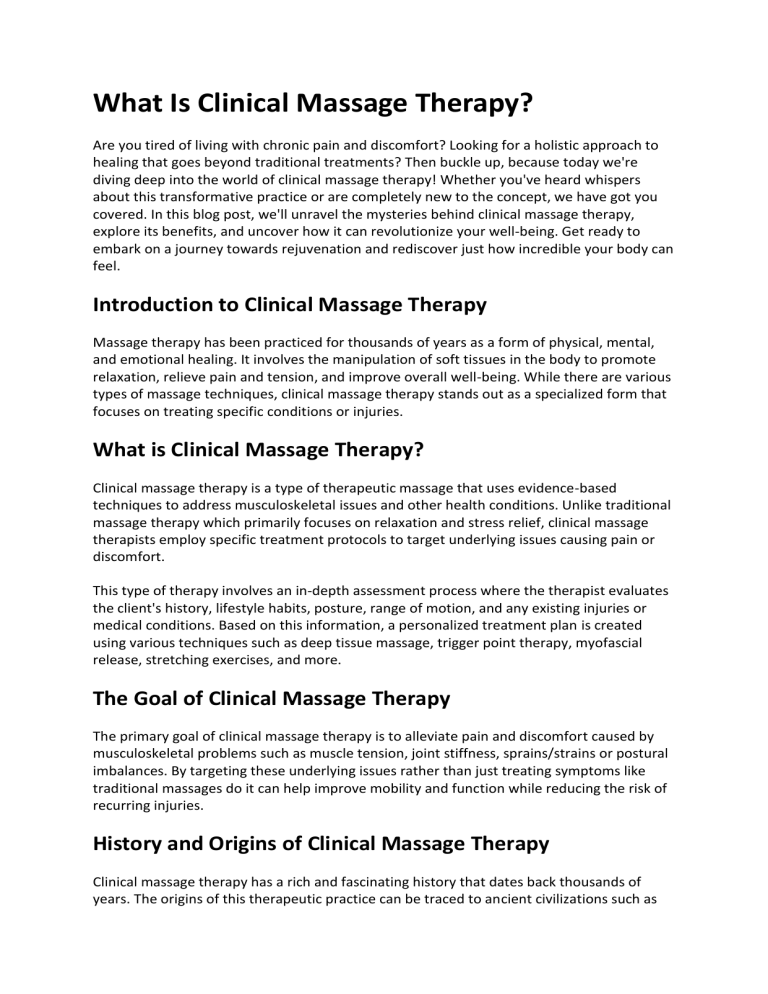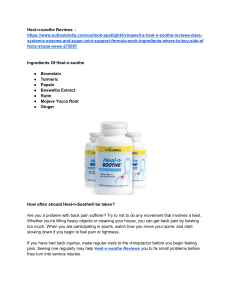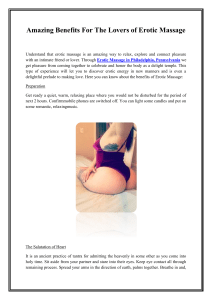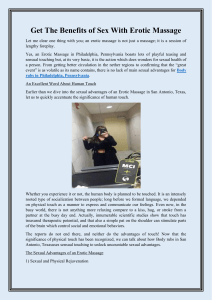
What Is Clinical Massage Therapy? Are you tired of living with chronic pain and discomfort? Looking for a holistic approach to healing that goes beyond traditional treatments? Then buckle up, because today we're diving deep into the world of clinical massage therapy! Whether you've heard whispers about this transformative practice or are completely new to the concept, we have got you covered. In this blog post, we'll unravel the mysteries behind clinical massage therapy, explore its benefits, and uncover how it can revolutionize your well-being. Get ready to embark on a journey towards rejuvenation and rediscover just how incredible your body can feel. Introduction to Clinical Massage Therapy Massage therapy has been practiced for thousands of years as a form of physical, mental, and emotional healing. It involves the manipulation of soft tissues in the body to promote relaxation, relieve pain and tension, and improve overall well-being. While there are various types of massage techniques, clinical massage therapy stands out as a specialized form that focuses on treating specific conditions or injuries. What is Clinical Massage Therapy? Clinical massage therapy is a type of therapeutic massage that uses evidence-based techniques to address musculoskeletal issues and other health conditions. Unlike traditional massage therapy which primarily focuses on relaxation and stress relief, clinical massage therapists employ specific treatment protocols to target underlying issues causing pain or discomfort. This type of therapy involves an in-depth assessment process where the therapist evaluates the client's history, lifestyle habits, posture, range of motion, and any existing injuries or medical conditions. Based on this information, a personalized treatment plan is created using various techniques such as deep tissue massage, trigger point therapy, myofascial release, stretching exercises, and more. The Goal of Clinical Massage Therapy The primary goal of clinical massage therapy is to alleviate pain and discomfort caused by musculoskeletal problems such as muscle tension, joint stiffness, sprains/strains or postural imbalances. By targeting these underlying issues rather than just treating symptoms like traditional massages do it can help improve mobility and function while reducing the risk of recurring injuries. History and Origins of Clinical Massage Therapy Clinical massage therapy has a rich and fascinating history that dates back thousands of years. The origins of this therapeutic practice can be traced to ancient civilizations such as India, China, and Egypt. These cultures believed in the healing power of touch and used massage techniques to relieve pain, promote relaxation, and restore balance in the body. In ancient India, massage was an integral part of Ayurvedic medicine – a holistic approach to health and wellness. The Ayurvedic texts mention various massage techniques and their benefits, making it one of the oldest documented forms of clinical massage therapy. Chinese medical texts dating back to 2700 BCE also contain references to massage therapy as a treatment for various ailments. The Chinese developed their own system of massage known as Tui Na, which is still widely practiced today. Egyptian hieroglyphs from 2500 BCE depict scenes of people receiving massages for medicinal purposes. Massage was considered an essential part of healthcare in ancient Egypt and was often performed by priests who were believed to possess healing powers. However, it wasn't until the 19th century that clinical massage therapy gained recognition in Western medicine. Swedish physician Per Henrik Ling is credited with developing the first systematic method of modern massage known as Swedish Massage. His techniques combined elements from Chinese Tui Na and Greek gymnastics and focused on promoting physical and mental wellbeing through manipulation of soft tissues. In the early 20th century, American physicians continued to explore different types of clinical massages for treating various conditions such as headaches, joint The Difference Between Clinical and Traditional Massage Therapy Clinical and traditional massage therapy are two popular forms of therapeutic treatment that use hands-on techniques to alleviate pain, promote relaxation, and improve overall well-being. While both types of massage involve the manipulation of soft tissues in the body, there are significant differences between them that make them unique in their approach and application. Clinical Massage Therapy: Clinical massage therapy, also known as medical or rehabilitative massage, is a specialized form of therapy that focuses on treating specific musculoskeletal conditions or injuries. It involves the assessment and treatment of soft tissue dysfunctions, such as muscle tension, trigger points, scar tissue formations, and postural imbalances. The goal of clinical massage therapy is to address the underlying cause of pain or discomfort rather than just providing temporary relief. A typical session with a clinical massage therapist starts with an initial evaluation where the therapist will discuss your medical history and note any areas of concern. This helps them understand your condition better so they can create a personalized treatment plan tailored to your needs. The therapist may also perform various tests and assessments to identify any muscular imbalances or restrictions that could be contributing to your symptoms. Benefits of Clinical Massage Therapy Clinical massage therapy is a specialized form of massage therapy that focuses on treating specific medical conditions. Unlike traditional relaxation massages, clinical massage therapists work with clients to address their underlying health concerns and provide targeted treatments to alleviate pain and improve overall well-being. There are numerous benefits of clinical massage therapy, making it an effective treatment option for a wide range of medical conditions. In this section, we will delve deeper into some of the key advantages of this type of massage therapy. 1. Reduced Pain and Muscle Tension: One of the primary benefits of clinical massage therapy is its ability to reduce pain and muscle tension. Through targeted techniques such as myofascial release, trigger point therapy, and deep tissue manipulation, clinical massage therapists can effectively relieve tight muscles and knots that contribute to chronic pain. By reducing muscle tension, clients experience improved range of motion, increased flexibility, and ultimately reduced pain levels. 2. Improved Posture: Postural problems are common among many individuals due to long hours spent sitting at desks or engaging in repetitive activities. Clinical massage therapy can help correct postural imbalances by targeting specific muscles groups responsible for improper alignment. By releasing tightness in these areas and improving muscle strength and flexibility through specialized exercises, clinical massage can significantly improve posture over time. 3. Stress Relief: Many people turn to traditional relaxation massages as a way to unwind after a stressful day or week. However, clinical massage takes stress relief one step further by addressing the physical symptoms caused by stress on the body. Conditions Treated by Clinical Massage Therapy Clinical massage therapy is a form of manual therapy that utilizes specialized techniques to treat various physical and psychological conditions. Unlike relaxation massage which focuses on providing a soothing experience, clinical massage therapy is specifically designed to address underlying health issues and promote healing. There are a wide range of conditions that can benefit from clinical massage therapy, including acute and chronic musculoskeletal pain, postural imbalances, sports injuries, stress-related disorders, and more. In this section, we will discuss some of the most common conditions treated by clinical massage therapy in detail. 1. Musculoskeletal Pain: One of the primary reasons people seek out clinical massage therapy is to alleviate musculoskeletal pain caused by injuries or chronic conditions such as arthritis. The therapist uses targeted techniques to release tension in muscles, reduce inflammation, and improve range of motion to provide relief from pain. 2. Postural Imbalances: Poor posture can lead to a host of problems including back pain, neck pain, headaches, and even digestive issues. Clinical massage therapy can help correct postural imbalances by releasing tight muscles and increasing flexibility in areas such as the chest, shoulders and hip flexors. 3. Sports Injuries: Athletes often turn to clinical massage therapy for rehabilitation from sports-related injuries such as sprains/strains or overuse injuries like tennis elbow or runner's knee. By focusing on specific muscle groups affected by the injury, therapists use techniques like deep tissue massage to aid in recovery and prevent future injuries. Techniques Used in Clinical Massage Therapy Clinical massage therapy is a specialized form of massage that focuses on treating specific musculoskeletal conditions and injuries. It utilizes various techniques to address the root cause of pain and discomfort, rather than just providing temporary relief. In this section, we will discuss some of the most commonly used techniques in clinical massage therapy. 1) Myofascial Release: This technique involves applying sustained pressure on the myofascial connective tissues to release tension and restrictions. Myofascial release helps improve blood flow, relieve pain, and increase range of motion. 2) Trigger Point Therapy: Trigger points are small areas within muscle fibers that can cause referred pain or discomfort throughout the body. In trigger point therapy, the therapist applies pressure to these points to release tension and alleviate pain. 3) Deep Tissue Massage: As the name suggests, this technique targets deep layers of muscles and connective tissues using slow strokes with deep pressure. It is particularly effective in treating chronic muscle tension and adhesions. 4) Neuromuscular Therapy: Also known as NMT, this technique involves manipulating soft tissue to balance the nervous system's interaction with muscles. It is often used to treat nerve compression syndromes like carpal tunnel syndrome or sciatica. 5) Active Release Technique (ART): ART is a movement-based massage technique that combines manipulation of soft tissue with active movements from the client. It aims to break down scar tissue adhesions and restore normal function in muscles. Finding a Qualified Practitioner Finding a qualified practitioner is crucial when seeking clinical massage therapy. It is important to ensure that the therapist you choose is properly trained and experienced in this specific type of therapy, as it requires a deep understanding of anatomy, physiology, and pathology. 1. Certification and Training: The first step in finding a qualified practitioner for clinical massage therapy is to look for certifications and training. A certified therapist has completed a comprehensive training program and has passed an exam to demonstrate their knowledge and skills in this field. Look for certifications from reputable organizations such as the National Certification Board for Therapeutic Massage & Bodywork (NCBTMB) or the American Massage Therapy Association (AMTA). 2. Specialization in Clinical Massage Therapy: While most massage therapists are trained in various techniques, not all of them specialize in clinical massage therapy. It is important to find a therapist who has specific experience and training in this area. This ensures that they have a deeper understanding of how to address specific conditions or injuries using massage techniques. 3. Experience: Along with certification and specialization, experience is also an essential factor when choosing a qualified practitioner for clinical massage therapy. Ask about their years of experience working with clients who have similar conditions as yours. Experienced therapists tend to have more knowledge about different conditions and can customize treatment plans according to individual needs. 4. Referrals and Reviews: Ask your friends or family members if they know any good massage therapists specializing in clinical massage therapy. Personal recommendations can be valuable as you get firsthand feedback on the therapist Frequently Asked Questions about Clinical Massage Therapy If you are considering trying clinical massage therapy, you probably have a lot of questions about what it entails and how it can benefit you. In this section, we will address some of the most frequently asked questions about clinical massage therapy. 1. What is clinical massage therapy? Clinical massage therapy is a type of therapeutic massage that focuses on treating specific medical conditions or injuries. It combines elements from different types of massages, such as Swedish and deep tissue, with techniques tailored to address the patient's specific needs. Unlike relaxation massages, which aim to provide general stress relief, clinical massage therapy targets specific problem areas or conditions. 2. What conditions can be treated with clinical massage therapy? Clinical massage therapy can be beneficial for a wide range of medical conditions and injuries. Some common issues that can be addressed include chronic pain (such as back pain or headaches), sports injuries, carpal tunnel syndrome, arthritis, fibromyalgia, and postoperative rehabilitation. It can also help relieve tension and stiffness in muscles caused by poor posture or repetitive strain injuries. 3. How does clinical massage therapy differ from traditional massages? While both traditional massages and clinical massages use touch to manipulate soft tissues in the body, their goals are quite different. Traditional massages focus on promoting relaxation and relieving tension throughout the body, while clinical massages aim to treat specific medical conditions or injuries through targeted techniques and pressure points. 4. Is clinical massage therapy painful? The amount of pressure applied during a clinical massage may vary depending on the patient's condition. Conclusion: Is Clinical Massage Therapy Right for You? After learning about the various aspects of clinical massage therapy, you may be wondering if it is the right choice for you. In this section, we will delve deeper into the factors that can help determine if clinical massage therapy is suitable for your specific needs and goals. 1. Understanding Your Health Concerns: The first step in determining if clinical massage therapy is right for you is to assess your current health concerns. Clinical massage therapy focuses on treating medical conditions and addressing pain and discomfort caused by injuries or chronic illnesses. If you are dealing with any physical ailments such as back pain, arthritis, migraines, or sports injuries, then clinical massage therapy could be a beneficial treatment option for you. 2. Your Comfort with Hands-On Therapy: Clinical massage therapy involves hands-on techniques that require close contact between the therapist and patient. If you are comfortable with physical touch and find it relaxing rather than uncomfortable or invasive, then this form of treatment may be suitable for you. However, if you have any reservations about being touched by a stranger, it's essential to communicate openly with your therapist before starting treatment. 3. Seeking Non-Invasive Treatment Options: Clinical massage therapy offers a non-invasive approach to managing pain and other health concerns compared to more traditional medical treatments like surgery or medication. It works by manipulating soft tissues in the body using gentle pressure and targeted movements to improve circulation, reduce inflammation, release tension or trigger points in muscles and promote overall healing. So if you prefer non-invasive treatments as an alternative to drugs or surgery, then clinical massage therapy may be a good fit for you. 4. Your Commitment to Health and Wellness: Clinical massage therapy is not a one-time fix for your health concerns; it's an ongoing process that requires commitment and dedication from the patient to see results. Depending on your condition, you may need to undergo several sessions of massage therapy before experiencing significant relief from your symptoms. If you are willing to put in the effort, follow through with any at-home exercises or self-care routines recommended by your therapist and make regular appointments, then clinical massage therapy could be a beneficial treatment for you. 5. Consult with a Professional: Before deciding if clinical massage therapy is right for you, it's crucial to consult with a professional licensed therapist who can assess your specific needs and recommend the best course of treatment. They can also answer any questions or concerns you may have about the process, potential risks, or expected outcomes based on your unique circumstances. In conclusion, clinical massage therapy can be an excellent option for individuals dealing with various health conditions seeking non-invasive treatment methods and looking to improve their overall well-being. However, it's essential to consult with a professional and assess your specific needs and goals before starting any form of treatment. Visit here to know more - https://noranugent.co.uk/clinical-massage-therapies/




